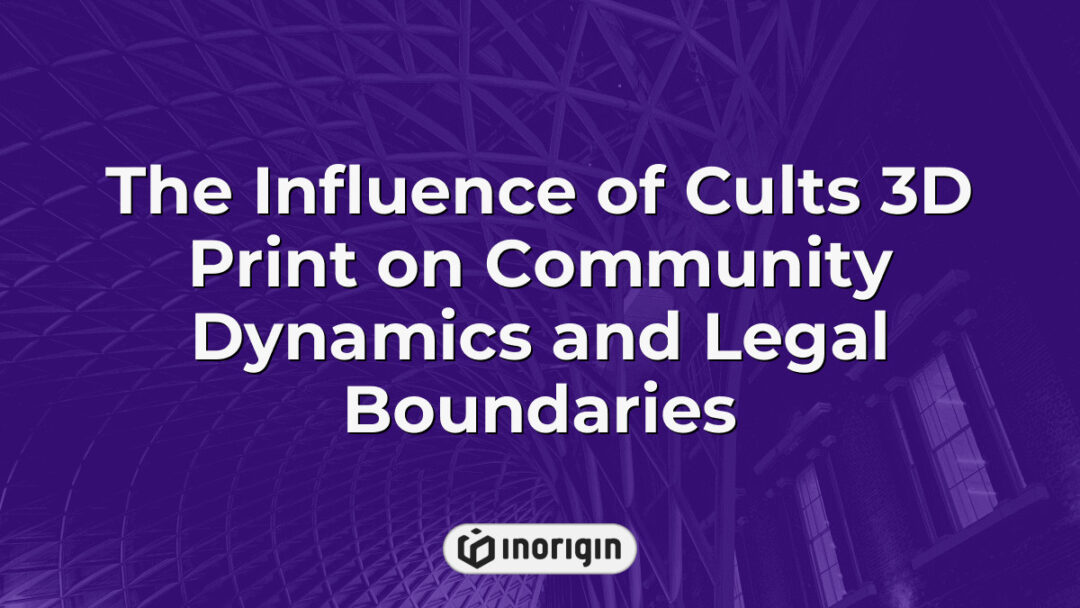The intersection of cult phenomena and modern technology presents a fascinating yet troubling landscape, particularly as niche groups increasingly turn to 3D printing to create a distinctive material culture that reflects their beliefs and practices. This article examines how the capabilities of 3D printing enable cults to produce unique artifacts, symbols, and tools that reinforce communal identity and ideology, challenging conventional understandings of craftsmanship and authenticity in a digital age. As these groups harness innovative technology to manifest their esoteric visions, a critical analysis of the implications arises, shedding light on the broader societal ramifications of tech-enabled subcultures. The exploration of 3D printing within cult environments not only illuminates the dynamic interplay of ideology and materialism but also raises essential questions about the nature of devotion, creativity, and the construction of belief systems in contemporary society.
| Aspect | Key Takeaway |
|---|---|
| Innovative Role of Cults 3D Print | Cults 3D print leverages advanced 3D printing technology to craft distinctive artifacts that embody their unique ideologies and enhance collective identity. |
| Community Formation and Dynamics | Online platforms facilitate the exchange of 3D printing designs among cult-like groups, strengthening community bonds and shared cultural symbols. |
| Distinctive Artifact Production | 3D printing allows creation of custom symbols and tools that deepen members’ connection and clearly express their shared beliefs. |
| Legal and Ethical Considerations | The rise of cult-focused 3D printing exposes regulatory gaps regarding intellectual property and the potential for unauthorized production of sensitive items. |
| Psychological Drivers | Individuals are drawn to these 3D printing communities seeking belonging, often developing strong emotional ties to group ideologies and practices. |
| Future Societal Impact | Expanding 3D printing capabilities may increase the influence of these niche groups, highlighting the need for dialogue balancing innovation with social and ethical responsibility. |
| Call for Informed Collaboration | Effective cooperation among designers, engineers, policymakers, and community leaders is critical to ensure safe and ethical use of 3D printing within such subcultures. |
Exploring the Rise of Cults in the 3D Printing Community
The rise of cult-like communities within the 3D printing sector warrants a critical examination, particularly in regards to their influence and dynamics. Initially, the allure of independent websites has facilitated the formation and development of these groups, often fostering a sense of belonging or identity among adherents. Not only do these platforms provide means for enthusiasts to exchange ideas and techniques, but they also sometimes propagate ideologies that can border on dogmatic. For instance, certain organisations advocate for specific types of 3D printing techniques, materials, or philosophies, which can inadvertently foster an insular mentality that marginalises outside opinions or practices. Additionally, as this phenomenon expands, the implications of such groupthink are evident, where originality may give way to conformity, thus stifling innovation within the broader 3D printing community. As members navigate these cultural currents, the intersection of technology and belief systems continues to provoke much-needed discourse on the balance between personal expression and collective identity in this rapidly evolving field.
Analyzing Popular 3D Printed Artifacts Among Cults
The phenomenon of 3D printing has given rise to a curious subculture: the cult-like communities that revolve around the creation and sharing of 3D printed artifacts. One might jest that in these circles, the sophisticated hum of extruders and the scent of heated filament could be mistaken for the ethereal sounds of a sacred gathering. Nonetheless, what truly captivates these enthusiasts is not just the technical prowess of crafting new 3D printer models but also the fervent fixation on specific projects that often blur the lines between hobbyist and devotion. For instance, certain groups meticulously design and print figurines inspired by their shared ethos, effectively transforming objects like statuettes and utilitarian tools into vessels of identity and belonging. This sociocultural tapestry reflects a significant trend: as the reliance on traditional manufacturing wanes, these cults increasingly galvanize their membership around the ideation and production of unique 3D printed artifacts. Intriguingly, the cross-pollination of creativity and community in this space not only fosters innovation but also encourages a sense of loyalty, transforming what may initially appear as merely another tech-driven trend into a deeply-rooted social phenomenon. There lies an intricate relationship between the artistry of printing and the communal notion of crafting; as one observes the proliferation of these artifacts, it becomes evident that the allure of 3D printing extends far beyond its technological dimensions, inviting exploration into the human desire for connection and creativity.
The Role of Online Platforms in Cults 3D Printing Activities
The role of online platforms in cults’ 3D printing activities has become increasingly significant, as these digital spaces facilitate not only the sharing of designs but also the distribution of 3D printer files that often cater to specific ideologies. For example, websites such as Thingiverse and MyMiniFactory allow users to upload and download files that cater to various interests, including those linked to subcultures and cults. Consequently, these platforms serve as repositories of creativity where members can access and replicate objects that embody their beliefs or practices, thereby strengthening a sense of community. In this context, the availability of these resources increases the ease with which individuals can engage in 3D printing, while simultaneously granting access to a wider range of artifacts that hold symbolic significance. Additionally, the online environment creates a space for dialogue and collaboration among members of these groups, fostering an ethos of shared creativity that transcends geographical barriers. These dynamics ultimately underscore the transformative impact of technology in the proliferation and maintenance of cult identities through the medium of 3D printing.
Safety and Legal Concerns Involving Cults and 3D Printing
Safety and legal concerns involving cults and 3D printing present a multifaceted issue. Engaging with this topic reveals a world where creativity can easily tip into ethical ambiguity. It invites critical reflection on the practices surrounding the production of potentially harmful objects. Several key aspects warrant consideration:
- Intellectual Property: Content developed by cults may infringe on existing patents or trademarks.
- Weaponization: The potential for 3D printing to create dangerous objects raises alarm about the misuse of technology.
- Regulatory Gaps: Current laws may not effectively govern the use of 3D printers within unconventional groups, which can enable unregulated production.
These concerns illustrate a paradox—the same technology that fosters innovation can simultaneously threaten public safety and ethical norms. Investigating these issues includes navigating the terrain of legal frameworks surrounding 3D models and the implications of distributing STL files, especially from communities with controversial practices. There’s an undeniable tension that exists when artistic exploration intersects with the potential for manipulation or even harm. As the prevalence of cults engaging in 3D printing increases, the urgent need for clearer legal parameters becomes evident. Addressing this matter requires collaboration among legal experts, technologists, and social scientists to forge a balanced approach that encourages creativity while safeguarding against potential abuses associated with these emerging practices.
Future Implications of 3D Printing in Cult Practices
The evolving role of 3D printing in cult practices raises significant questions regarding its design and future implications. As technology continues to develop, the ease of creating customized materials can incite both fascination and dread. With the ability to fabricate objects ranging from innocuous trinkets to more nefarious tools, the potential uses for cults present a dual-edged sword; that is, the innovation’s capacity for craft and indoctrination cannot be ignored. Transitioning to the specifics of these implications reveals complex dynamics that necessitate careful scrutiny.
- Potential applications of 3D printing in cult practices:
- Creation of religious artifacts and symbols that are unique to specific groups
- Custom designs may enhance members’ sense of belonging
- Diverse aesthetics could attract new followers
- Development of tools or devices that may facilitate control
- Creating surveillance equipment to monitor followers
- Producing weapons under the radar of legal restrictions
The shift toward accessible 3D printing technology could inadvertently provide tools for manipulation, as digital blueprints become easier to acquire and modify. This raises alarm about not only the physical items that can be manufactured but also the psychological implications embedded within those items. A cult’s capacity to craft symbols that hold profound significance—both personal and communal—bears consequences for social dynamics and identity formation. Consequently, the intersection between 3D printing and cult practices heralds a future where innovation might empower practices that challenge established norms or ethical boundaries, drawing attention to the need for a critical dialogue surrounding both technological advancement and safeguarding against exploitation.
Frequently Asked Questions
What are the psychological factors that lead individuals to join cults focused on 3D printing?
The phenomenon of individuals joining cults, particularly those centred around niche interests like 3D printing, has attracted increasing scholarly attention. Research indicates that approximately 25% of people involved in these groups cite a desire for community and belonging as a driving force behind their engagement. This desire often stems from feelings of isolation or disenchantment with mainstream society. Once individuals become involved in a cult-like environment, various psychological factors further reinforce their commitment. For instance, social identity theory suggests that group affiliation can create a sense of self-worth, as individuals may derive a significant part of their identity from membership within a tightly-knit community. As these members become more entrenched in the cult’s ideologies—often accentuating innovation and exclusivity—they may experience cognitive dissonance, making it increasingly challenging to distance themselves or critique the group’s beliefs. Over time, this can lead to a form of dependency, where the individual’s perception of reality becomes deeply intertwined with the group’s narrative. Understanding these psychological dynamics sheds light on the allure of such communities, especially those involved in cutting-edge technologies like 3D printing, hinting at a broader commentary on societal fragmentation in contemporary life.
How do cults in the 3D printing community compare to traditional cults in terms of structure and beliefs?
Cults, like shadows cast by an unseen light, emerge in various domains of human interest, including the niche yet increasingly popular sphere of 3D printing. These organisations, while drawing on the foundational similarities found in traditional cults—such as strong charismatic leadership, a distinct ingroup and outgroup mentality, and often, a set of ideologically rigid beliefs—often diverge in their focus and structure. The 3D printing cults may centre around a specific technology or a lifestyle choice, adhering to doctrines that elevate the practice of 3D printing into almost a sacred ritual, akin to a modern-day craft guild yet with deeper psychological undercurrents. For instance, members often engage in communal activities, such as collaborative builds or group printing sessions, where dedication to the craft can overshadow traditional social interactions, thus creating an insular community. The beliefs held by these groups frequently involve the idea that they possess superior know-how or unique insights into the 3D printing world, which feeds into a larger narrative about elitism within a burgeoning technology. This can lead to an environment rife with gatekeeping tendencies, reminiscent of established cult dynamics, where loyalty to the group supersedes individual critical thinking. Ultimately, the intersection of technology and community forms a unique complexion for 3D printing cults, highlighting how shared interests can morph into fervent ideologies that parallel those found in more conventional cults.
What are some personal stories or testimonials from individuals who have left cults involved in 3D printing?
Stepping into the world of 3D printing cults can feel like walking through a rabbit hole, where the normal rules of community and belief seem to bend and warp into something quite distinct. Personal accounts from individuals who have distanced themselves from these groups reveal a complex interplay of emotional and psychological elements that often echo the experiences of those exiting more traditional cults. For instance, one former member recounted the initial allure of the community, describing it as a sanctuary for creativity, with members bonding over shared passions for innovation and technology. However, as time went on, this sense of belonging morphed into a suffocating environment where dissent was discouraged and loyalty to the group took precedence over personal freedom. Similarly, another individual highlighted the manipulative tactics employed, where the leaders would exploit the members’ desire for validation and mastery in 3D printing, creating a cycle of dependence that was difficult to break. Such testimonies illustrate the manipulative dynamics at play, showcasing how the intersection of technology and community can foster environments that resemble those found in more traditional cults, albeit with a modern twist. The recurring themes of isolation, manipulation, and the struggle for individual agency are central to understanding the experiences of those who have been ensnared in these 3D printing cults.
Conclusion
In conclusion, the intersection of cults and 3D printing unveils a complex tapestry of creativity and potential peril. As technological advancements forge new avenues for expression and influence, it becomes imperative to navigate this landscape with caution. The shadows of innovation can sometimes obscure the path to enlightenment, urging vigilance.
Related posts:
- Cults 3D printing Revolutionizing Ritual Artifacts with Advanced Precision and Ethical Innovation
- Cult 3D Printing Communities Shaping Ethical Innovation and Collaborative Design Trends
- Cults 3D Prints Revolutionizing Artifact Creation and Technological Integration in Cult Communities
- 3D printing sites with curated designs and expert community support for advanced prototyping
- Alien Engineered Products and Their Impact on Advanced Technology Discoveries
- 3D printer files free and expert resources for flawless prototype production




